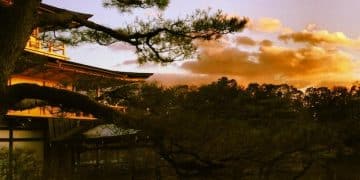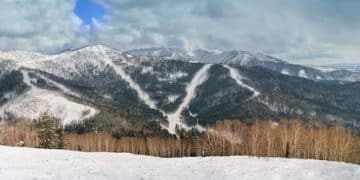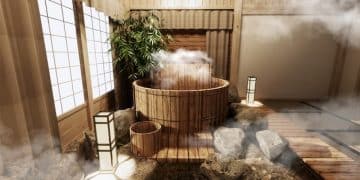Japan’s Onsen Experience: A First-Timer’s Guide for US Travelers
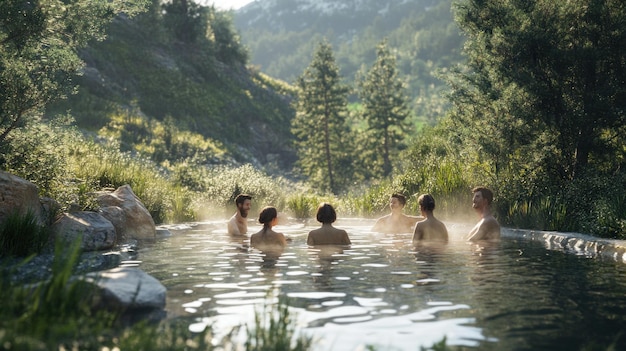
Japan’s onsen experience offers US first-timers a unique opportunity to immerse themselves in Japanese culture, enjoying therapeutic hot springs while learning proper etiquette and discovering the best onsen destinations across Japan.
Planning your first trip to Japan? Don’t miss out on the quintessential Japanese experience: onsen. This guide is tailored for US travelers eager to delve into the world of Japanese hot springs, ensuring a relaxing and culturally enriching adventure.
Understanding Japan’s Onsen Culture
Onsen, or Japanese hot springs, are more than just a place to bathe; they’re a cornerstone of Japanese culture. Rooted in history and tradition, onsen offer relaxation, therapeutic benefits, and a social experience unlike any other. Understanding the cultural significance is key to appreciating and properly enjoying your Japan’s onsen experience.
The History and Tradition of Onsen
The history of onsen dates back centuries, with early mentions in ancient texts. Initially, they were used for medicinal purposes, believed to heal various ailments. Over time, onsen evolved into social gathering places, offering respite and relaxation for communities. Today, that tradition continues, blending historical practices with modern amenities.
Types of Onsen: From Indoor to Outdoor
Onsen come in various forms, each offering a unique experience. Indoor onsen, often found in hotels and traditional inns (ryokans), provide a convenient and private setting. Outdoor onsen (rotenburo), on the other hand, offer stunning views of nature, enhancing the sense of tranquility. Some onsen even feature different mineral compositions, each with unique therapeutic properties.
- Indoor Onsen: Found mainly in hotels and ryokans, they offer privacy and convenience.
- Outdoor Onsen (Rotenburo): Provide scenic views and a connection with nature.
- Mineral Springs: Each boasts unique therapeutic properties based on its mineral composition.
Understanding these distinctions lets you maximize your enjoyment when experiencing Japan’s onsen experience. From historical roots to modern relaxation, the tradition of onsen embodies the essence of Japanese culture.
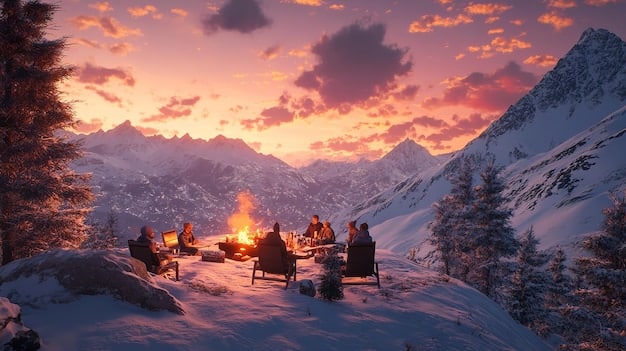
Onsen Etiquette: A Guide for First-Timers
Navigating the etiquette of onsen can initially feel daunting for US first-timers. However, understanding and adhering to these customs is crucial to ensure a respectful and enjoyable experience. Proper onsen etiquette reflects Japanese values of cleanliness, consideration, and harmony. Here’s a breakdown to ease your transition into Japan’s onsen experience.
Pre-Bathing Rituals: Washing and Preparing
Before entering the onsen, it’s essential to thoroughly wash your body at the provided bathing stations. These stations offer soap, shampoo, and small stools. You should sit while washing to avoid splashing others. Rinsing off all soap is crucial, so that you enter the onsen water clean.
What to Wear (or Not Wear) in an Onsen
The traditional onsen experience involves bathing nude. However, some onsen allow the wearing of bathing suits, especially in mixed-gender settings. Small towels are often provided; these are used for modesty or to place on your head. Avoid submerging the towel in the onsen water.
- Nudity: Generally required in gender-separated onsen.
- Small Towels: Used for modesty or placed on the head, never submerged.
- Bathing Suits: Sometimes permitted in mixed-gender onsen.
Respecting these guidelines lets you both avoid cultural faux pas and embrace the tranquility of Japan’s onsen experience. Adhering to onsen etiquette ensures that all visitors feel comfortable and can enjoy the restorative ambiance of these unique hot springs.
Choosing the Right Onsen: A Variety of Options
When embarking on Japan’s onsen experience, selecting the right onsen is essential to match your preferences and expectations. Japan offers an astonishing variety of onsen, ranging from traditional ryokans to modern spa resorts. Consider your interests, budget, and the type of experience you seek to ensure the right fit.
Ryokans with Onsen: Traditional Japanese Inns
Ryokans, or traditional Japanese inns, often feature onsen as a significant part of their appeal. Staying at a ryokan allows you to fully immerse yourself in Japanese hospitality, complete with tatami-mat rooms, traditional cuisine, and access to both indoor and outdoor onsen. It’s an ideal way to enhance your overall onsen experience.
Public Baths (Sento) vs. Private Onsen
While onsen generally refer to hot springs using natural water sources, sento are public bathhouses that use heated tap water. Sento provide a less expensive and more communal bathing experience, while private onsen, often found in high-end ryokans, offer a more secluded and personalized experience.
– **Sento**: Public bathhouses using heated tap water, offering an affordable communal experience.
– **Private Onsen**: Found in upscale ryokans providing seclusion and personalized service.
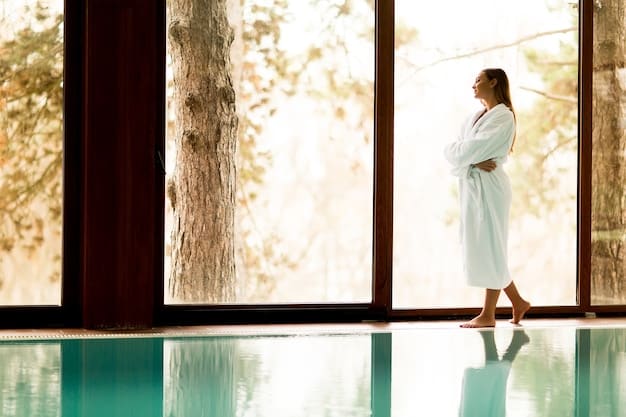
Considerations for Choosing an Onsen
Several factors should influence your choice of onsen. Consider the location, accessibility, and amenities offered. Also, review the onsen’s policies regarding tattoos, as some establishments may restrict entry to individuals with visible tattoos. Reading online reviews and seeking recommendations can assist you in making an informed decision. By evaluating these elements, you will ensure a memorable and suitable Japan’s onsen experience.
The Health Benefits of Onsen
Beyond relaxation and cultural immersion, Japan’s onsen experience is renowned for its numerous health benefits. The mineral-rich waters found in onsen are believed to alleviate various ailments and promote overall well-being. Understanding these benefits can enhance your appreciation for the therapeutic aspects of onsen.
Mineral Composition and Therapeutic Effects
Different onsen boast varying mineral compositions, each with distinct therapeutic properties. For instance, sulfur springs are believed to relieve skin conditions, while iron-rich springs are thought to help with anemia. Carbon dioxide springs can improve blood circulation. The specific combinations of minerals contribute to the unique therapeutic effects experienced in various onsen.
Onsen for Relaxation and Stress Relief
The warm water and serene environment of onsen can help promote relaxation and alleviate stress. Immersing oneself in an onsen can lower blood pressure, soothe tense muscles, and induce a sense of calm. This makes onsen a popular choice for those seeking respite from the pressures of everyday life.
- Sulfur Springs: Alleviate skin conditions.
- Iron-Rich Springs: Help with anemia.
- Carbon Dioxide Springs: Improve blood circulation.
By understanding the health benefits tied to natural mineral content and understanding of the mind and body connection, you can truly transform your Japan’s onsen experience to be one of recovery and overall well being. Combining relaxation with therapeutic minerals, one can maximize the health-boosting potential of Japanese hot springs.
Top Onsen Destinations in Japan
When planning your journey for a Japan’s onsen experience, knowing the best destinations is essential. Japan has a plethora of onsen towns and resorts, each with unique characteristics and attractions. Here are some top destinations that warrant consideration.
Hakone: Scenic Mountain Views and Onsen Resorts
Hakone is a mountain resort town near Tokyo. It’s famous for its stunning views of Mount Fuji and numerous onsen resorts. The area provides a variety of onsen experiences, ranging from traditional ryokans to modern hotels, often accompanied by exquisite natural scenery.
Kusatsu: High-Temperature Waters and Traditional Atmosphere
Kusatsu is another popular onsen destination known for its high-temperature waters and traditional atmosphere. The town features the iconic Yubatake, a wooden structure used to cool the hot spring water, and several public bathhouses, making it feel truly authentic.
Beppu: The Onsen Capital with Unique Hot Spring Experiences
Located on the island of Kyushu, Beppu has a variety of hot springs, including mud baths, sand baths, and steam baths. This makes it a unique onsen destination. Also, the “Hells of Beppu,” are colorful, non-bathing onsen used to enjoy the geothermal phenomenon of the area.
- Hakone: For scenic views and varied onsen resorts
- Kusatsu: For high-temperature waters and a traditional experience
- Beppu: For unique hot spring experiences such as mud and sand baths
Exploring these top destinations enhances Japan’s onsen experience, offering diverse environments and unique hot spring options. Each region delivers distinctive ways to appreciate the cultural and therapeutic nature of onsen beyond the well-known destinations.
Planning Your Onsen Trip: Tips and Considerations
Successfully planning your Japan’s onsen experience requires thought, especially if you’re coming from the US for the first time. From transportation to accommodation, several important points merit consideration to ensure a smooth and enjoyable adventure.
Transportation Options: Getting to Onsen Towns
Various options exist for traveling to onsen towns within Japan. The extensive train network, including the Shinkansen (bullet train), provides efficient access to many popular onsen destinations. Buses and rental cars are also viable options, offering flexibility for exploring more remote areas. Plan your route according to your itinerary and budget.
Accommodation Choices: Ryokans, Hotels, and More
Accommodation options at onsen destinations range from traditional ryokans to modern hotels and guesthouses. Ryokans offer an immersive cultural experience, while hotels provide more familiar amenities. Select lodging according to your preference and budget to enhance your stay.
Budgeting for Your Onsen Experience
Budgeting for your onsen experience depends on various factors, including transportation, lodging, meals, and onsen fees. Ryokans generally cost more than hotels, and some onsen require entrance fees. Plan your expenditure by estimating costs and setting a budget limit to prevent unexpected expenses while you enjoy Japan’s onsen experience.
| Key Point | Brief Description |
|---|---|
| ♨️ Onsen Etiquette | Proper washing & nudity are generally required. Follow local customs for a respectful experience. |
| 🏞️ Onsen Types | Indoor & outdoor options. Mineral springs offer varied health benefits. |
| 📍 Top Destinations | Hakone, Kusatsu, and Beppu are popular spots with unique features. |
| ✔️ Planning Tips | Consider transport, lodging, and budget. Check tattoo policies. |
Frequently Asked Questions
▼
Before entering, wash thoroughly at the bathing stations provided. Remove all clothing as nudity is generally required. Use a small towel for modesty, but avoid submerging it in the water.
▼
Many onsen do not allow tattoos due to their association with organized crime. Some may allow entry if tattoos are covered by a bandage or provided covering. Always check in advance.
▼
Onsen offer various health benefits depending on the mineral composition of the water. These include relaxation, stress relief, improved circulation, and alleviation of skin conditions.
▼
Yes, some onsen are mixed-gender, but they often require wearing a bathing suit. These are less common than gender-separated onsen, so look for them in resort areas.
▼
Typically, the onsen supplies a small towel, soap, shampoo, and conditioner. However, consider bringing your own toiletries if you have specific preferences. A change of clothes is also a must.
Conclusion
Embarking on Japan’s onsen experience offers a unique blend of cultural immersion, relaxation, and health benefits. With careful planning and respect for local customs, US first-timers can ensure a memorable and rejuvenating trip to Japanese hot springs. Enjoy the warmth, traditions, and serenity that these onsen have to offer.

